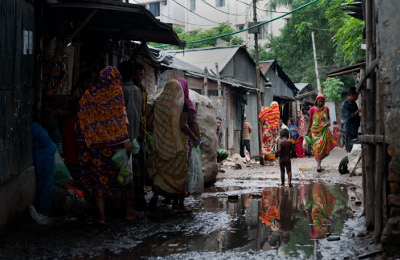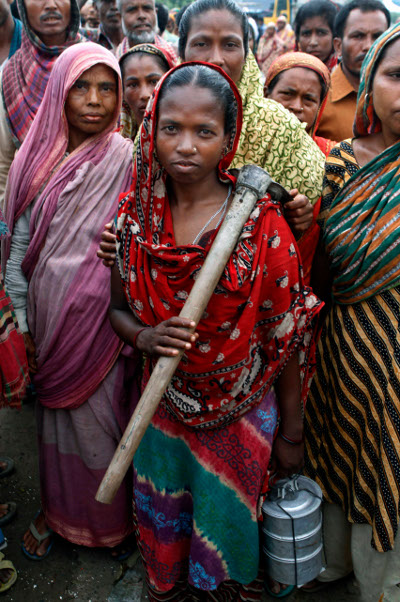Letter from a Reader:
The Hellhole of Dhaka, Bangladesh
June 9, 2013 | Revolution Newspaper | revcom.us
Dear Revolution editors,
When I saw the coverage in the media of the terrible tragedy in Bangladesh, I recalled a visit I had made to that country a number of years ago. I am not in a position to propose a deep analysis of the garment industry in Bangladesh. I am happy to see that your newspaper has published several hard-hitting articles on Rana Plaza and hope you will continue to hold the capitalists in the West as well as their Bangladeshi "outsourcers" responsible for this crime. Still, perhaps a few personal observations might be of interest to your readers.

Photo: AP
The first thing that needs to be said is that Dhaka is a hellhole. While the countryside of Bangladesh is lush and extremely fertile (virtually the whole country is a nutrient rich flood plain), for decades extreme poverty and lack of land has pushed huge numbers of former peasants from the villages to the capital. At first glance one would think the entire country is young―children everywhere but also huge numbers of young men and women desperate for work of any kind.
Tens of thousands of young men pull bicycle-driven rickshaws―the main means of transportation in Dhaka. Often they are carrying whole families loaded with luggage for mere pennies. But while the young men tend to be visible, what the women do is largely hidden from public view.
You mainly see the young women twice a day―early in the morning not long after sunrise when the streets of Dhaka swarm with hundreds of thousands of young women going to the garment factories on foot. At first glance most of them seem to be no older than twenty-five. I was told that an hour walk or even longer to work is quite normal. They are readily distinguished from the occasional woman student by the rice lunch the workers are carrying from home in a metal container, which will be all they will be eating until the return walk on foot after a very long day.
While some of the garment shops may fit the Western stereotype of a sweatshop (for example, dirt floors and old, dilapidated buildings), most of them are actually quite modern in appearance. Five or more stories high, non-elegant but sturdy-appearing modern buildings―just like the Rana Plaza that came crashing down burying alive more than 1,200 people, mostly young women. The tragedy after tragedy in Bangladesh are just as modern as the latest fashions shipped back to the U.S. and Europe.

Photo: AP
Acquaintances of mine from Dhaka told me bits and snatches of what life was like for the women garment workers. A great many of the women were subjected to various forms of sexual abuse by male supervisors, in particular bodily "searches" on leaving work. Extremely low wages, of course. Wages so low, in fact, that it was very often impossible for women to quit one job, no matter how intolerable, and move to another since in such cases they were almost sure to lose several weeks pay. The companies generally made sure that they were a month or so behind in payment and would rarely pay a worker who quit. Even missing pay for a few days, let alone several weeks, could easily mean the difference between eating or not. Recall that the workers went back into Rana Plaza even after large cracks were discovered not because they were unaware of the danger but because their bosses were threatening to withhold the pay of anyone who didn't show up for work. The collapse of the building was not certain, severe hunger for themselves and family was assured if they refused.
After a long day the flood reverses direction and the streets teem with tired women on their way home. And a visitor begins to get a sense of what $37 a month minimum wage means. Here rickety, hastily thrown-together shacks serve as the counterpoint to the modern concrete structures where the garments are sewn. In Dante's Inferno, the medieval Italian poet portrays Hell as having nine distinct levels with each lower level reserving more horrors and tortures. After just a few days in Dhaka a visitor begins to sense that Dhaka's hell is also stratified into layers, going further and further downward. A large section of the workers (many, most, almost all? I don't know) live in conditions that really defy description. Because Dhaka is on the flood plain there is water everywhere. Generally it is foul and stinking of human excrement. Still, people are forced to rely on such sources of water for bathing and cleaning. Not surprisingly, mosquitoes are everywhere and the skin of the children who live and play in this squalor is full of sores. Many of the children have the extended stomachs symptomatic of malnutrition.
A large percentage of the young women already have children to take care of when they arrive home (again, I really don't know how many). Not only do the garment companies not offer any assistance, often the women must conceal the fact that they have children in order to get the job in the first place. Before going back to work the next day the women must prepare food for themselves and their children with labor-intensive and primitive means.
What I found astounding is that despite the squalor and poverty, the women somehow manage to wash their clothes and keep clean. A hard battle every day, on top of the factory work, to keep from becoming completely degraded.
When I last visited Bangladesh there were "'only" one or two million garment workers. Now there are four million. The repeated murderous fires and building collapses are tragic concentrations of the bitter reality that these millions face daily.

Photo: AP
If you like this article, subscribe, donate to and sustain Revolution newspaper.
